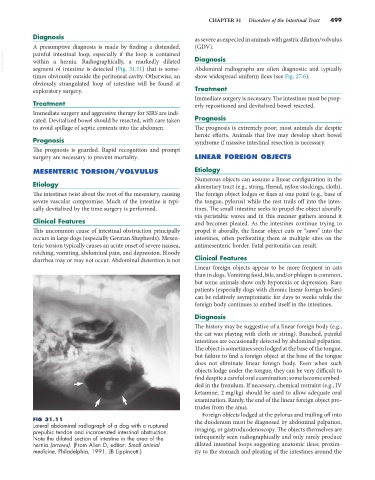Page 527 - Small Animal Internal Medicine, 6th Edition
P. 527
CHAPTER 31 Disorders of the Intestinal Tract 499
Diagnosis as severe as expected in animals with gastric dilation/volvulus
A presumptive diagnosis is made by finding a distended, (GDV).
VetBooks.ir painful intestinal loop, especially if the loop is contained Diagnosis
within a hernia. Radiographically, a markedly dilated
segment of intestine is detected (Fig. 31.11) that is some-
show widespread uniform ileus (see Fig. 27.6).
times obviously outside the peritoneal cavity. Otherwise, an Abdominal radiographs are often diagnostic and typically
obviously strangulated loop of intestine will be found at
exploratory surgery. Treatment
Immediate surgery is necessary. The intestines must be prop-
Treatment erly repositioned and devitalized bowel resected.
Immediate surgery and aggressive therapy for SIRS are indi-
cated. Devitalized bowel should be resected, with care taken Prognosis
to avoid spillage of septic contents into the abdomen. The prognosis is extremely poor; most animals die despite
heroic efforts. Animals that live may develop short bowel
Prognosis syndrome if massive intestinal resection is necessary.
The prognosis is guarded. Rapid recognition and prompt
surgery are necessary to prevent mortality. LINEAR FOREIGN OBJECTS
MESENTERIC TORSION/VOLVULUS Etiology
Numerous objects can assume a linear configuration in the
Etiology alimentary tract (e.g., string, thread, nylon stockings, cloth).
The intestines twist about the root of the mesentery, causing The foreign object lodges or fixes at one point (e.g., base of
severe vascular compromise. Much of the intestine is typi- the tongue, pylorus) while the rest trails off into the intes-
cally devitalized by the time surgery is performed. tines. The small intestine seeks to propel the object aborally
via peristaltic waves and in this manner gathers around it
Clinical Features and becomes pleated. As the intestines continue trying to
This uncommon cause of intestinal obstruction principally propel it aborally, the linear object cuts or “saws” into the
occurs in large dogs (especially German Shepherds). Mesen- intestines, often perforating them at multiple sites on the
teric torsion typically causes an acute onset of severe nausea, antimesenteric border. Fatal peritonitis can result.
retching, vomiting, abdominal pain, and depression. Bloody
diarrhea may or may not occur. Abdominal distention is not Clinical Features
Linear foreign objects appear to be more frequent in cats
than in dogs. Vomiting food, bile, and/or phlegm is common,
but some animals show only hyporexia or depression. Rare
patients (especially dogs with chronic linear foreign bodies)
can be relatively asymptomatic for days to weeks while the
foreign body continues to embed itself in the intestines.
Diagnosis
The history may be suggestive of a linear foreign body (e.g.,
the cat was playing with cloth or string). Bunched, painful
intestines are occasionally detected by abdominal palpation.
The object is sometimes seen lodged at the base of the tongue,
but failure to find a foreign object at the base of the tongue
does not eliminate linear foreign body. Even when such
objects lodge under the tongue, they can be very difficult to
find despite a careful oral examination; some become embed-
ded in the frenulum. If necessary, chemical restraint (e.g., IV
ketamine, 2 mg/kg) should be used to allow adequate oral
examination. Rarely, the end of the linear foreign object pro-
trudes from the anus.
Foreign objects lodged at the pylorus and trailing off into
FIG 31.11 the duodenum must be diagnosed by abdominal palpation,
Lateral abdominal radiograph of a dog with a ruptured
prepubic tendon and incarcerated intestinal obstruction. imaging, or gastroduodenoscopy. The objects themselves are
Note the dilated section of intestine in the area of the infrequently seen radiographically and only rarely produce
hernia (arrows). (From Allen D, editor: Small animal dilated intestinal loops suggesting anatomic ileus; proxim-
medicine, Philadelphia, 1991, JB Lippincott.) ity to the stomach and pleating of the intestines around the

